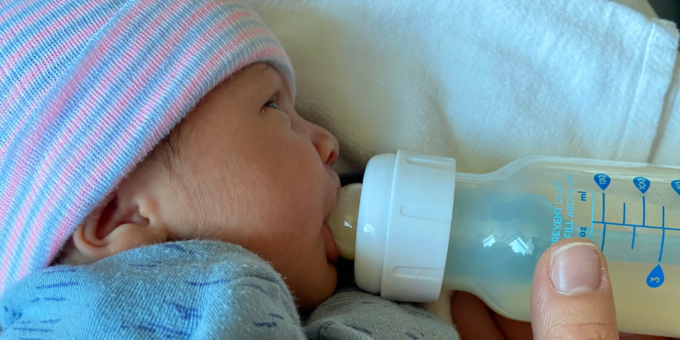There may be questions you have when it comes to premature baby feeding. You’ll want to know more about your preemie baby’s nutrition and feeding schedule regardless of whether you are breastfeeding or formula feeding. Pres feeding preemies require a little more attention than full-term babies.
Premature Baby Feeding in the NICU
While in the neonatal intensive care unit (NICU), feeding can be challenging for preemies. Breastfeeding or bottle-feeding may be difficult for premature babies due to their lack of strength or coordination. With a bit of help, preemies can overcome their feeding challenges. Learning some simple techniques and knowing how to get extra guidance can help your preemie gain weight and grow steadily by understanding why he is having trouble.
Feedings in the NICU generally fall into three categories. How your baby eats depends on how early she/he was born and her/his medical condition.
1. IV feeding

Source: verywellfamily.com
Those born before 28 weeks or very ill usually receive their first nutrients through an IV because they cannot coordinate sucking and swallowing before 32 to 34 weeks of gestation. This method, also known as total parenteral nutrition (TPN) or hyperalimentation, bypasses the immature digestive system of your preemie to provide him or her with nutrients directly from the bloodstream.
What’s in the IV? On the first day, it may be water, sugar, and amino acids. Your baby will receive a custom blend of protein, fat, sugar, vitamins, minerals, and fluids afterward.
Your baby cannot digest breast milk at this point. If you plan to breastfeed, start pumping and freezing milk as soon as possible after giving birth. By doing this, you’ll be able to build up your supply to have plenty when your baby is ready. NICU nurses will likely encourage you to cuddle your baby as much as you want skin-to-skin (kangaroo care) as long as she maintains her body temperature outside the warming isolette.
2. Gavage feeding
If your baby is born before 32 to 34 weeks of gestation, it may be unable to swallow and suck, so it cannot feed by mouth. Most babies born between 28 and 34 weeks of gestation can tolerate gastrointestinal feedings and may not require IV nutrition. Infants who started on TPN but now tolerate milk feedings may receive food directly in their stomachs via a tube, galled gavage feeding.
A thin, flexible tube is passed down to the stomach through the baby’s mouth or nose. Your baby will receive pumped breast milk, fortified breast milk, or formula specially designed for preemies through the tube. Your baby’s doctor will determine the amount and frequency.
You can give your baby kangaroo care while she/he eats by holding the tube your baby’s nurse teaches you how to do. To get her/him used to suck, you can even give her/him a finger to use so that she/he gets to practice and begins to associate sucking with being whole.
3. Breast and bottle-feeding

Source: washingtonpost.com
This is a huge accomplishment!
Neonatal doctors will look for signs that your baby is ready for breastfeeding or bottle feeding, though the timing varies from baby to baby. Some little ones are ready as early as 30 to 32 weeks, while others may not be ready until 36 weeks.
Signs that your little one might be ready for breast- and/or bottle feeding:
- Vital signs are stable
- No signs of abdominal distension
- She/he is no longer on a ventilator
- She/he can effectively suck on a pacifier
- Stays awake for longer periods
If everything is okay, you’ll probably be given the go-ahead to start giving your baby formula or breast. Even if you intend to breastfeed and use a bottle, try providing the breast first. According to studies, low birth weight newborns are more likely to latch onto the breast than the bottle.
If you bottle-feed your child, a unique little plastic bottle with cubic centimeters (cc) or milliliters marking will be used (ml). The flow rate of these specially created nipples is suitable for premature infants.
You could ask a nurse to demonstrate the proper bottle-feeding position for your preemie because it may differ slightly from that of a full-term baby.
Because nipple feeding might exhaust such a tiny infant, initially, you’ll only nurse one or two times a day.
How to feed your preemie at home?

Source: handtohold.org
Your breast milk supply and your baby’s growth will increase if you are exclusively nursing by the time you arrive home together. After you leave the hospital, you might or might not need to continue using formula made especially for preemies if you’re formula feeding (or using a mix). The Milky Box is a highly reputable store with a diverse offer of golden standard baby formulas.
Your doctor will advise you on the proper formula to use and how much you should give your baby based on your child’s development.
Never forget that the side of nurturing care you offer sustenance, whether it be from your breast, a bottle with pumped milk, or a bottle with formula, is vital.
Final thoughts
It can be frightening and intimidating to have a preemie in the NICU. You may be concerned about whether your baby is receiving the proper kind and quantity of nutrition despite your desperation for them to grow at a healthy rate. It may be upsetting to not be able to nurse immediately away.
Although the staff in NICUs is there to support you and your preemie, they are also there to help babies just like yours flourish. Develop a feeding strategy that can improve your baby’s growth and, whenever possible, promote bonding in collaboration with the doctors and nurses. With these tiny, priceless humans, progress could be slower than you’d want, but it’s still crucial to rejoice in small accomplishments.







